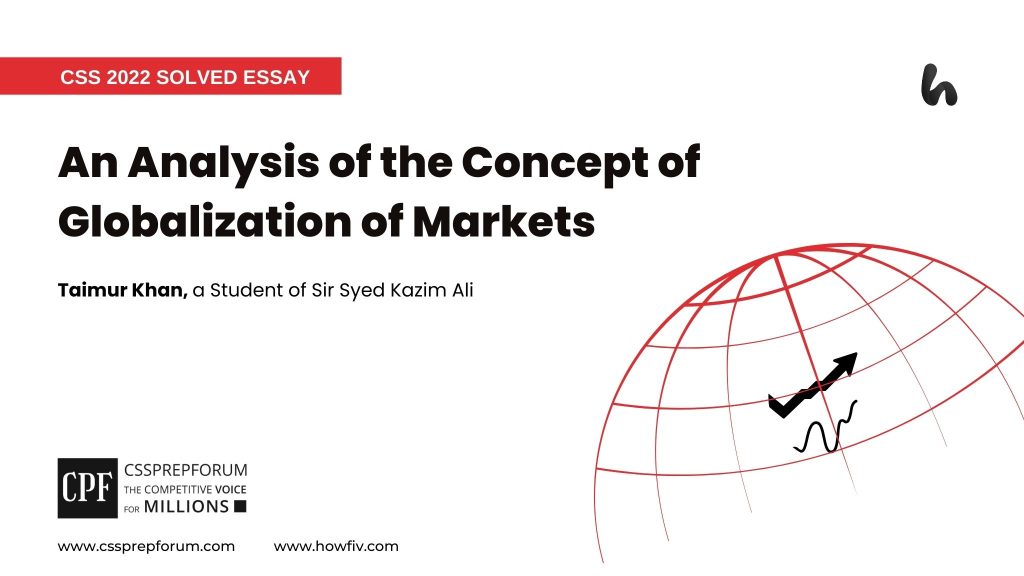CSS 2022 Solved Essays | An Analysis of the Concept of Globalization of Markets
Taimur Khan, a Sir Syed Kazim Ali student, has attempted the CSS 2022 essay “An Analysis of the Concept of Globalization of Markets” on the given pattern, which Sir Syed Kazim Ali teaches his students. Sir Syed Kazim Ali has been Pakistan’s top English writing and CSS, PMS essay and precis coach with the highest success rate of his students. The essay is uploaded to help other competitive aspirants learn and practice essay writing techniques and patterns to qualify for the essay paper.

1- Introduction
- ✓ Although the establishment of an integrated global financial system, the advancement in manufacturing and transportation technologies and decent growth in international migration patterns through the globalization of markets have some benefits globally, it has proved detrimental to developing countries as the process has given rise to core-periphery relations between the North and South in the technological sphere, retarded economic development in the newly globalized nations, invited the exploitation by the global corporations, allowed financial crises, exacerbated poverty and inequality, enhanced commodity dependence, harmed domestic agriculture sector, and contributed to the environmental degradation.
2- Understanding the globalization of markets
3- What are the salient drivers of the globalization of markets?
- ✓ Policies of modernization, industrialization, and economic liberalization
- Case in point: The structural adjustment programs in developing countries, perestroika in Russia in the 1990s, and trade liberalization in China and India allowed the globalization of the markets.
- ✓ The development of the global integrated digital financial system
- Case in point: Since WWII, the US dollars, involving 90 per cent of foreign exchange transactions, as estimated by the Bank of International Settlements, the Swift system, as well as electronic banking, has accelerated states and global corporations to conduct their business in a single global market arena.
- ✓ Growth of efficient manufacturing, transportation and information technologies
- Case in point: The technological improvement leading to advanced manufacturing technologies, such as computer-based design and products (CAD), computer-controlled equipment, and robotics; and transportation technologies, such as containerization, fuel-efficient jumbo jets, and Universal Product Code, have aided companies to globalize their products, leading to e-commerce and e-business worldwide.
- ✓ Increase in global migration
- Case in point: Migration, according to the National Library of Medicine (NIH), not only changed the workforce composition of many multinational corporations (MNCs) but also enhanced the internationalization process of Chinese firms, as per the International Business Review.
4- How has the globalization of markets proved detrimental to developing economies?
- ✓ Technological dependence of the global South on the North
- Case in point: MNCs originating from the developed world have a limited penchant for strategically aligning with local firms in terms of developing, innovating, and transferring technologies to developing economies, resulting in Core-Periphery relations between the developed and developing countries (Italian National Research Council).
- ✓ Global unequal opportunities structure for local firms in the global market
- Case in point: The globalization of markets has created an asymmetrical impact of global markets on local markets, which have low productive assets and hence are receptible to a minuscule foreign investment (Brookings).
- ✓ Exploitation of MNCs in developing nations
- Case in point: The deregulation of labour markets resulting in the abolishing of labour unions has exploited labour in developing countries, with the Reuters recording thousands of labourers protesting against low wages were forced into layoffs by local apparel manufacturing firms supplying global MNCs like H&M and Next.
5- What are some benefits that the globalization of markets offers globally?
- ✓ Emergence of global economic players
- Case in point: Although the globalization of markets has given rise to highly globalized emerging economies challenging the Western-led economic global world order, it has made these nations vulnerable to economic crises, such as what happened in the 1997 banking crisis hitting the Newly-Industrialized Countries (NICs) in the East Asian region.
- ✓ Augmentation of global economic interdependence
- Case in point: The globalization of markets has widened economic interdependence through international trade and transnational supply and value chains, preventing interstate conflicts, but it has led to underdevelopment in most parts of the world with market-led growth strategies.
- ✓ Increase in global wealth
- Case in point: Globalization of markets has really created economies of scale, thereby increasing global capitalism; however, it has created commodity-dependence economies, a problem that most of the developing countries, or about eighty-five per cent, suffer from, according to the United Nations Conference on Trade and Development (UNCTAD).
✓ The globalization of market failure: a case study of Bangladesh
Case in point: The market capture of synthetic fibre produced in the US through capital-intensive techniques against the natural fibre cultivated in Bangladesh has resulted in the decrease of the latter’s commodity from 1.0 million to fifty-two thousand metric tons due to its price decrease in the international market, reflecting the negative outcomes of globalization of markets in the form ruining local industry and destroying the environment (University of Massachusetts).
6- Critical Analysis
7- Conclusion

Historically, markets have almost always existed at community, country, and regional levels. However, the advent of globalization has transformed once-scattered markets into a single global market, dubbed the globalization of markets. Nonetheless, this globalization of markets has created asymmetrical impacts for different nations. Although the globalization of markets, driven by economic liberalization at the state level, the establishment of an integrated global financial system, the advancement in manufacturing and transportation technologies, and decent growth in international migration patterns have some benefits for developed countries. That includes multiplying emerging economic players, enhancing interdependence, and increasing economies of scale. However, on the other hand, it has proved detrimental to developing countries as the process has given rise to core-periphery relations between the North and South in the technological sphere. It has also retarded economic development in the newly globalized nations, invited global corporations to exploit them, permitted financial crises, exacerbated poverty and inequality, enhanced commodity dependence, and harmed their domestic agriculture sector. Undoubtedly, the globalization of markets may have benefitted some emerging economies by challenging Western globalization strategies, creating global interdependence and enhancing economies of scale. However, it has not only ruined local industry in developing nations due to international commerce but also devastated their environment.

Before highlighting the drivers of the globalization of markets, it is imperative to explore the meaning of the phrase. The term globalization of markets refers to ‘’the merging of historically distinct and separate national markets into one huge global marketplace.”. Globalization of markets, according to Theodore Levitt, who coined the term, anticipated the effects of globalization on international business owing to advancements in technology and changing social behaviours. In fact, it is globalization that has fundamentally changed the manner in which global markets are structured, having had significant implications for not only international business- as anticipated by Levitt, but also consumers, economies worldwide and the environment. First, globalization has broadened firms’ horizons by viewing the entire world as one single market, hence a source of goods, services, capital, labour, and knowledge. Second, firms may enhance their operations by generating synergies by cooperating with international businesses through joint ventures and strategic alliances. In short, the globalization of markets has changed the very structure of the previously scattered markets on national levels, morphing into a single humongous global market.
Having examined the meaning of the phrase, it is pertinent to highlight the drivers of the globalization of markets. To begin with, the modernization, industrialization, and, above all, trade liberalization policies adopted by the developing countries during the heydays of the Cold War ushered in the process of the globalization of markets. First, the modernization of the agriculture sector in developing countries through the Green Revolution in the 1960s paved the way for agro-based industrialization in these countries. The modernization also fostered gross income that allowed enhancement in the living standards, thereby creating a market for high-value products in developing countries. Thus, modernization and industrialization accelerated international trade, whereby firms in both developing and developed nations found the entire world to be a market audience. Second, the trade liberalization in the two most populous nations, China and India, in the 1980s and 1990s, respectively, aided the integration of world markets, leading to the globalization of markets. In addition, the trade liberalization in the context of structural adjustment Programs (SAPs) in the 1980s onwards in developing countries and the policies of perestroika, or restructuring after the fall of the Belin Wall in Russia, along with the de-Sovietization of various erstwhile Soviet Union countries, had laid down an enabling environment for the restructuring of international markets. Therefore, the national-level policies had initially laid a foundation for the globalization of markets to get momentum, paving the way for the firms to stretch their muscles the world over.
Besides national initiatives, the global financial system has also caused the globalization of markets. Three interrelated financial components are responsible for the globalization of markets. First, the integration of markets has enabled firms to borrow and raise capital, which has increased from six per cent of the world GDP in the 1980s to fifteen per cent in 2006, according to the International Monetary Fund (IMF). Second, it has aided internationally oriented firms in conducting their business smoothly through US dollars, enhancing financial certainty in international payments. For instance, according to the Bank of International Settlement, about ninety per cent of the foreign exchange takes place in US dollars. Third, the advent of the Society for Worldwide Interbank Financial Telecommunication System (SWIFT), a messaging network aimed at providing safe and secure financial transactions for its members comprising individuals and financial institutions, has revolutionized international markets by providing the beneficiaries a streamlined method for international payments and settlements. In brief, the ballooning global capital market, dollar-dominated international trade, and the SWIFT system are responsible for the globalization of markets.
In addition to smooth international financial infrastructure, since globalization involves every aspect of technology, technological improvements in manufacturing, transportation, and information communication have also helped the globalization of markets flourish. The state of the art manufacturing technologies such as both Computer-aided Design(CAD) and Computer-aided Manufacturing (CAM) have increased the international outreach of manufacturing companies by not only increasing their volume but also efficiency and quality yet at a cost-effective way, which is also helpful in reverse engineering, a bedrock of China’s global market capture. In addition, technological improvements such as containerized transportation and the development of fuel-efficient commercial jumbo jets have also enhanced the working of global markets. Containerized systems of transportation help increase productivity, decrease expenses, and form standardized logistics. It also helps in enabling intermodal transportation as containerized products can be transported by other modes of transportation such as trains, trucks, and ships–helping in the standardization of global trade. Furthermore, information and communication technologies such as electronic banking, the World Wide Web and the adoption of UPC increasing the flow of goods worldwide, have created e-business and e-commerce, leading to the global digital economy, totalling about 43.7% of the world GDP, according to Multidisciplinary Digital Publishing Institute MDPI. Therefore, technological improvement has altered the structure of markets, allowing companies to rapidly globalize their services and products.
Besides, the enhanced transboundary migration has also fostered the globalization of markets. Globalization involves migratory shifts, which have increased to 3.6 per cent in the last decade as a proportion of people living outside their country of origin, according to the International Organization for Migration. Migratory shifts impact the way firms conduct their business ventures relating to human resource management and their entry mode, especially concerning foreign direct investment (FDI). For example, in the top hundred metropolitan areas in the USA, where the headquarters of many non-US MNEs are based, the growth in the highly skilled categories of migrants has transformed the workforce composition of many transnational corporations, bearing implications for not only the staffing and diversity policies of companies but also the setting up of entrepreneurial ventures back home (National Library of Medicine). Moreover, migration has also provided the context in which firms enter into foreign markets as they carry with them specific value systems operating transnationally. In fact, migration, according to the International Business Review, has helped Chinese firms’ internationalization process. China uses FDI as a tool not only to implement its business ventures through the Chinese workforce abroad but also to gain knowledge-related assets overseas, thus creating synergies through the local migrants’ intercourse in business ventures. For example, the Asian Survey reported that a sixty-thousand-strong Chinese workforce was working on the Pakistan Economic Corridor (CPEC). In a nutshell, migration has not only integrated global human resource capital in the context of organizational culture but also consolidated investment portfolios.
The above-mentioned drivers of globalization have contributed to the phenomenon of globalization of markets. However, the globalization of markets has produced asymmetrical impacts, with most of the developing countries at the receiving ends of the phenomenon. In fact, it has precluded the developing nations from competing with the ever-powerful juggernaut of multinationals of the Western countries aided by favourable economic order. Therefore, the globalization of markets has proved detrimental to developing nations in a variety of ways.
To begin with, the globalization of markets has manufactured the technological dependence of developing countries on the developed world. The neoclassical model regarding technological inducement argues that technology is a given and, thus, a free market would help transform technology from the developed world to the under-developed markets. Nonetheless, despite having adopted the free market philosophy, the developing nations have yet to fully benefit from the fruit of global technological development for the following reasons. First, most of the MNCs, the vehicle for the transmission of technology across the world, have a limited tendency to neither ground their R&D and innovative activities in developing countries, which comprises less than ten per cent of these activities nor establish patents in host countries, which are concentrated mostly in technologically advanced countries (Italian National Research Council). Second, according to the Journal of Technology Management, nearly ninety-four per cent of the recorded strategic technology partnering (STP) involves the developed world, barring some partnerships with the newly Industrialized Countries(NICs). Third, the developing countries have neither the human capital to operate, improve, adapt, and innovate nor the technological infrastructure to record patents, leaving these countries to “collect the crumbs of the multinationals. In short, although globalization of markets may offer technological transfer from the rich countries to the poor ones, technological transfer is a distant dream for the developing countries owing to the nonchalant behaviour of the MNCs to develop technology in these countries, the lack of technology related strategic partnership with the under-developed world, as well as the lack of human capital in developing nations to fully harness technological advancement, creating a core-periphery relations between the South and the North.
Besides discouraging technological transfer to developing countries, the globalization of markets has no built-in structure for the local economies to reap the benefits of investment opportunities. Most of the developing nations have enjoined the globalized system of marketplace lately long after the developed world had created strong economies to be integrated into the globalization of markets, making the former countries unable to produce strong private sector. On the other hand, developed countries have created a strong private sector, strengthening their firms’ operations as transnational corporations. This transnational corporation, in turn, has a very strong foothold in developing countries, obstructing the growth and development of local business firms. In addition, since the globalization of markets favours only those firms that already have decent productive assets and economies of scale in the transnational business environment, the overly dependent on MNCs, ultimately, has created an unequal opportunities structure where national and global corporations can compete. Although the presence of multinationals is ubiquitous, the non-C MNCs investment is paltry in developing countries, leaving the developing countries at the hands of rapacious transnational corporations. For instance, according to the Brookings, nearly eighty per cent of foreign investment occurs in industrialized countries, with less than one per cent of the US investment going to sub-Saharan Africa. In short, the globalization of markets has favoured multinationals in developing nations, leaving the latter with fewer investment opportunities.
In addition to obstructing reaping the benefits from global investment, the globalization of markets has put the developing world at the mercy of exploitative business activities like environmental destruction and preventing real wages of labour due to weak regulatory governance and deregulated labour markets in the developing world. For instance, according to the United Nations Conference on Trade and Development (UNCTAD), about eighty per cent of global trade, which increased from twenty per cent to forty per cent from 1990 to 2013, primarily through MNCs, reflecting their prowess in global market structure. However, the MNCs in developing countries engaging in such activities as purchasing raw materials, outsourcing production, and selling to consumers have subdued economic development by making these economies occupy low-value-added activities such as supplying low-value raw materials. Furthermore, the MNCs have exploited natural resources by engaging in environmentally unsustainable activities such as excessive water extraction for foreign firms, fragile waste management systems, and deforestation, to name a few. As an example, seven of the top ten fossil fuel emitters are headquartered in developing countries (World Benchmarking Alliance). In addition, since the globalization of markets has integrated the labour markets the world over, it has exploited labour relations in developing economies through global supply chains. For instance, at least three apparel manufacturers in Bangladesh supplying H&M, Mauritiz, and Next about USD five billion garments annually laid off thousands of workers attached to labour unions protesting against low wages in 2018, according to Reuters. In a nutshell, the globalization of markets has resulted in the MNCs wielding undue economic power, leading to environmental destruction and labour exploitation in developing nations.
Globalization of markets has resulted in the exploitation of resources, inhibited global investment, and failed to transfer technology to developing countries. Nonetheless, some still view the globalization of markets with favourable perspectives.
First, the globalization of markets, some argue, has given rise to new economic players like India, China, Brazil, and Russia by creating new opportunities for businesses in these emerging economies, challenging the dominance of those countries benefiting from global markets. The argument, therefore, goes that the globalization of markets has also generated wealth in these economies, leading to higher living standards and increasing global output growth. However, the integration of emerging economies through the globalization of markets caused financial crises like the East Asian Financial Crisis of 1997 due to their exposure to global financial markets and the Great Recession of 2008, leading to currency devaluation and inflation in Argentina, Mexico, and Turkey. Second, globalization of markets, as some of its proponents would argue, has enhanced the integration of markets, broadening trade, boosting investment, and establishing complex supply chains, resulting in economic interdependence, often through multilateral blocks such as the European Union and NAFTA, leading to benign inter-state relations. The globalization of markets aiding economic relations among states might prevent interstate conflicts; nonetheless, it has not only failed to reduce poverty within the underdeveloped world but also increased inequality between the rich and poorer countries. To illustrate, the SAPs in developing nations since the 1980s have increased the reliance on markets for social policy objectives, but it has miserably failed to bridge the gap between the poor and the wealthy countries. For instance, poverty, according to the United Nations Development Program, remains high in underdeveloped countries, except for a few developing countries like China and India. Similarly, the ratio of the average income of the richest to the poorest countries in the nineteenth century was nine to one; today, the average family in the US is sixty times richer than that in Ethiopia or Bangladesh (the Benchmark Alliance).
The third argument in favour of globalization of markets is its positive role in increasing global wealth. The argument goes that the increase in transnational capital through globalization of markets allows national units of production to transform into global units, creating economies of scale through comparative advantage, trans- trans-transnationalization of production and capital ownership, as well as advanced technological and manufacturing technologies, etc., has multiplied global economic wealth. However, the benefits of global wealth have not trickled down to the poor nations. For example, according to the Harvard Business Review, despite market-oriented reforms and opening up to the international markets, financial, capital, and production, these countries are still unable to diversify and boost their exports or attract investment. Similarly, the globalization of markets has furthered commodity dependence, a market situation where an economy solely depends on exporting a commodity that may threaten its export base when that commodity is hit in the international market of developing countries. Most of the countries enlisted in UNCTAD’s commodity-dependent nations are developing countries, reflecting the negative impacts of globalization of markets.
Also, the globalization of markets in commodity trade not only obstructed national industries from flourishing in developing countries but also invited environmental destruction. The phenomena can be elaborated through a case study of Bangladesh’s natural fibre industry destroyed by the US’s synthetic fibre. Moreover, globalization of markets has sidelined natural raw materials such as cotton, jute, and wool, the mainstay of developing economies, in favour of synthetic substitutes produced in developed countries owing to the market decline of natural fibres in the developed world. The impacts of the decline are two-fold: the loss of market capture for natural fibre and the environmental cost associated with synthetic substitutes. For instance, the import of Bangladesh’s jute, producing about eight per cent of the total production and engaging a quarter of the population in the country, plummeted to North America and Europe from a million to a paltry fifty-two thousand metric tons while also decreasing its price by seventy per cent in the last three decades, as per a research by the University of Massachusetts. Regarding environmental degradation, polypropylene fabric, the main synthetic substitute for jute produced and marketed in developed countries, is highly hazardous to the environment. For instance, its production technique is highly environmentally destructive and emits environmental pollutants like particulates, sulfur oxides, nitrogen oxides, carbon monoxide, and ammonia. Similarly, its energy use in production is six times greater than that of jute. In brief, not only has the globalization of markets destroyed the local agriculture sector in developing countries, but it has also created environmental hazards under the garb of competitiveness and efficiency, the hallmark of globalization of markets.
In conclusion, although globalization of markets may offer some opportunities for developing nations, it has proved inimical for these countries. Modernization, industrialization, and liberalization of national governments across the world laid the foundation for the phenomenon since WWII. The international capital markets, the use of a single currency, i.e., the US dollar, the SWIFT system, and technological improvements in manufacturing and transportation have helped global markets flourish. Migration patterns have also driven the globalization of markets through global human resource development and foreign investment. Globalization of markets has failed to satisfy the needs of developing nations. It has failed to transfer technology and bring long-term investment to poor nations. It has also encouraged the perpetuation of the exploitative business activities of the MNCs. Although the globalization of markets has helped create emerging economies, economic interdependence, and increased global wealth, it has given rise to financial crises, increased poverty and inequality, and commodity dependence. Globalization of markets not only prevented the national economic sectors from stagnating but also proved disastrous for the environment.

CSS Solved Past Papers’ Essays
Looking for the last ten years of CSS and PMS Solved Essays and want to know how Sir Kazim’s students write and score the highest marks in the essays’ papers? Then, click on the CSS Solved Essays to start reading them.
CSS Solved Essays
CSS 2022 Solved Essays
Are you searching for CSS 2022 solved essays by Sir Syed Kazim Ali’s students? Click on any of the topics to start reading the solved essays.
| 1- | An analysis of the concept of globalization of markets. |
| 2- | Digital democracy: social media and political participation. |
| 3- | Global trade and trade policies of China. |
| 4- | “Imagination is more important than knowledge”. |
| 5- | Global politics and international relations. |
| 6- | The controversial issues of feminism in contemporary women’s rights movements. |
| 7- | World food systems: the economics of agriculture. |
| 8- | Is there such a thing as ethical consumerism? |
| 9- | Human development and economic sustainability. |
| 10- | How are terrorism and its perception shaped by the Mass Media? |
CSS Solved General Science & Ability Past Papers
Want to read the last ten years’ General Science & Ability Solved Past Papers to learn how to attempt them and to score high? Let’s click on the link below to read them all freely. All past papers have been solved by Miss Iqra Ali & Dr Nishat Baloch, Pakistan’s top CSS GSA coach having the highest score of their students. General Science & Ability Solved Past Papers
Articles Might Interest You!
The following are some of the most important articles for CSS and PMS aspirants. Click on any to start reading.












